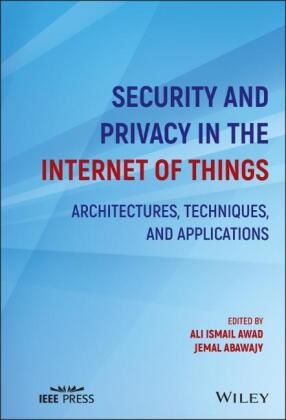Mehr lesen
SECURITY AND PRIVACY IN THE INTERNET OF THINGS
Provides the authoritative and up-to-date information required for securing IoT architecture and applications
The vast amount of data generated by the Internet of Things (IoT) has made information and cyber security vital for not only personal privacy, but also for the sustainability of the IoT itself. Security and Privacy in the Internet of Things brings together high-quality research on IoT security models, architectures, techniques, and application domains. This concise yet comprehensive volume explores state-of-the-art mitigations in IoT security while addressing important security and privacy challenges across different IoT layers.
The book provides timely coverage of IoT architecture, security technologies and mechanisms, and applications. The authors outline emerging trends in IoT security and privacy with a focus on areas such as smart environments and e-health. Topics include authentication and access control, attack detection and prevention, securing IoT through traffic modeling, human aspects in IoT security, and IoT hardware security. Presenting the current body of knowledge in a single volume, Security and Privacy in the Internet of Things:
* Discusses a broad range of IoT attacks and defense mechanisms
* Examines IoT security and privacy protocols and approaches
* Covers both the logical and physical security of IoT devices
* Addresses IoT security through network traffic modeling
* Describes privacy preserving techniques in smart cities
* Explores current threat and vulnerability analyses
Security and Privacy in the Internet of Things: Architectures, Techniques, and Applications is essential reading for researchers, industry practitioners, and students involved in IoT security development and IoT systems deployment.
Inhaltsverzeichnis
About the Editors xiii
List of Contributors xv
Preface xix
1 Advanced Attacks and Protection Mechanisms in IoT Devices and Networks 1
Lejla Batina, Nele Mentens, Markus Miettinen, Naila Mukhtar, Thien Duc Nguyen, Md Masoom Rabbani, Phillip Rieger, and Ahmad-Reza Sadeghi
1.1 Introduction 2
1.2 Physical Security in IoT Devices 3
1.2.1 Physical Attacks 3
1.2.1.1 Side-channel Analysis Attacks 3
1.2.1.2 Fault Analysis Attacks 4
1.2.2 Profiling Attacks 4
1.2.3 Machine Learning and SCA 5
1.2.4 Real-world Attacks 7
1.2.5 Countermeasures 8
1.3 Remote Attestation in IoT Devices 9
1.3.1 Types of Remote Attestation 10
1.3.1.1 Software-based Remote Attestation 10
1.3.1.2 Hardware-based Remote Attestation 11
1.3.1.3 Hybrid Architecture-based Remote Attestation 12
1.3.2 Remote Attestation for Large IoT Networks 12
1.3.2.1 Classical Swarm Attestation Techniques 12
1.3.2.2 Swarm Attestation for IoT Services 14
1.3.3 Future Directions 14
1.3.3.1 Cloud-based RA Techniques 15
1.3.3.2 RA in Novel Internet Technologies 15
1.3.3.3 Blockchain Based RA 15
1.4 Intrusion Detection in IoT Networks 15
1.4.1 IoT Malware 15
1.4.2 Vulnerability Patching 16
1.4.3 Signature- and Anomaly Detection-based Network Intrusion Detection 17
1.4.4 Deep Learning-based Anomaly Detection 17
1.4.4.1 System Overview 18
1.4.4.2 Modeling Packet Sequence Patterns 18
1.4.4.3 Anomalous Packet Detection 19
1.4.5 Federated Deep Learning-based IoT Intrusion Detection System 20
1.4.5.1 Federated Learning 20
1.4.5.2 Federated Self-Learning Anomaly Detection 20
1.4.5.3 Challenges of Federated Learning-based Anomaly Detection System for IoT 22
References 23
2 Human Aspects of IoT Security and Privacy 31
Sune Von Solms and Steven Furnell
2.1 Introduction 31
2.2 An Overview of the Domestic IoT Environment 33
2.3 Security Issues and the IoT Landscape 39
2.4 Human Factors Challenges in IoT Security and Privacy 41
2.4.1 Security Trade-offs for Individuals in IoT 43
2.4.2 Data Ownership and Use 44
2.4.3 Device Management and Administration Responsibilities 46
2.4.4 The Age of Unwanted Intelligence 47
2.5 Toward Improved User-facing Security in the IoT 49
2.6 Conclusion 51
Acknowledgments 51
References 51
3 Applying Zero Trust Security Principles to Defence Mechanisms Against Data Exfiltration Attacks 57
Hugo Egerton, Mohammad Hammoudeh, Devrim Unal, and Bamidele Adebisi
3.1 Introduction 57
3.2 Data Exfiltration Types, Attack Mechanisms, and Defence Techniques 59
3.2.1 Types of Data Exfiltration 59
3.2.1.1 Physical 59
3.2.1.2 Remote 60
3.2.2 Data Exfiltration Attack Techniques 60
3.2.2.1 Physical-based 60
3.2.2.2 Remote-based 61
3.2.3 Insider Data Exfiltration Threats 63
3.2.3.1 Types of Insider Threats 63
3.2.4 Approaches to Counter Data Exfiltration 65
3.2.4.1 Preventative 65
3.2.4.2 Detective 66
3.2.4.3 Investigative 66
3.2.5 Mechanisms to Defend Against Physical Data Exfiltration 67
3.2.5.1 Network-based 67
3.2.5.2 Physical-based 67
3.3 A Defence Mechanism for Physical Data Exfiltration Mitigation 68
3.3.1 Confidential Data Identification 68
3.3.2 Endpoint Access Rules 70
Über den Autor / die Autorin
ALI ISMAIL AWAD, PhD, is currently an Associate Professor with the College of Information Technology (CIT), United Arab Emirates University (UAEU), Al Ain, United Arab Emirates. He is also an Associate Professor with the Department of Computer Science, Electrical and Space Engineering, Luleå University of Technology, Luleå, Sweden. He is an Associate Professor with the Electrical Engineering Department, Faculty of Engineering, Al-Azhar University at Qena, Qena, Egypt. He is also a Visiting Researcher at the University of Plymouth, United Kingdom. Dr. Awad is an Editorial Board Member of the Future Generation Computer Systems Journal, Computers & Security Journal, the Internet of Things, Engineering Cyber Physical Human Systems Journal, Health Information Science and Systems Journal, and IET Image Processing Journal. Dr. Awad is currently an IEEE senior member.
JEMAL H. ABAWAJY, PhD, is a full professor at Faculty of Science, Engineering and Built Environment, Deakin University, Australia. He is a Senior Member of IEEE Society; IEEE Technical Committee on Scalable Computing (TCSC); IEEE Technical Committee on Dependable Computing and Fault Tolerance and IEEE Communication Society. His leadership is extensive spanning industrial, academic and professional areas (e.g., IEEE Technical Committee on Scalable Computing, Academic Board, Faculty Board and Research Integrity Advisory Group). Professor Abawajy is currently the Director of the Distributing System Security (DSS).

